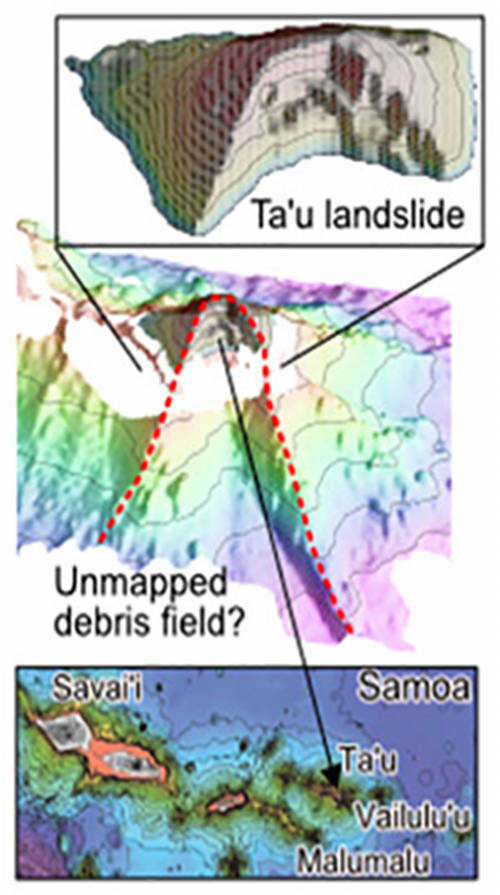
Jasper Konter - University of Hawaii at Manoa
February 20, 2017
Dr. Matthew Jackson, geology lead for the expedition, discusses the formation of the shape of Ta'u Island, and the effect that volcanic activity has had on the island's past and could have on the region's future. Video courtesy of the NOAA Office of Ocean Exploration and Research, 2017 American Samoa. Download (mp4, 122.4 MB).
Samoan volcanoes are some of the largest hotspot volcanoes in the Pacific Ocean, surpassed in volume only by some of the Hawaiian Islands. Hotspot volcanoes grow near sea level, meaning that the interaction of their lava with shallow seawater may result in explosive eruptions. These explosive eruptions can present a hazard to local populations as well as any ship traffic in an area.
Explosive eruptions may also generate volcanic sediment layers that form weak zones between the predominant submarine pillow lavas and/or lava flows, leading to volcanic flank failure. This has led to the common occurrence of large-scale (mainly submarine) landslides around volcanic ocean islands, as has been defined in areas such as Hawai‘i and the Canary Islands.

Figure 1: The landslide scar on Ta‘u can only be partially traced. All discussed Samoan volcanoes are shown in the bottom panel. Image courtesy of Jasper Konter, University of Hawaii Manoa. Download image (jpg, 72 KB).
Hawaiian landslides occur in two forms: gradual, slow-moving slumps and catastrophic debris avalanches. The catastrophic events displace a significant portion of the volcano onto the surrounding seafloor (e.g., the Hawaiian Nu‘uanu landslide displaced nearly 5,000 cubic kilometers of material). This displacement can in turn trigger a tsunamigenic event. Computer models, together with potential tsunami deposits, suggest wave heights of hundreds of meters near the actual landslide are possible. Not all of the various components that affect waves generated by submarine landslides are as well understood as they are for earthquake-generated tsunami.
In the case of Samoa, limited available mapping data shows portions of two landslides (near Savai‘i and Ta‘u islands; Fig. 1). On the island of Ta‘u, the southern section of the volcano is quite clearly missing , and the landslide scar can be traced underwater (Fig. 1). However, the seafloor around the Samoan Islands is only sparsely mapped, and as a consequence, the debris field from the landslide that likely reshaped Ta‘u has not yet been mapped.
Being mostly unmapped is the case for most of the young volcanoes in Samoa, and therefore it is presently largely unknown how many landslides have occurred in the area and over what time span. It is therefore difficult to assess how often these events have happened in Samoa and what the severity of this type of disaster is.
Limited mapping of these areas is being done during part one of the 2017 American Samoa Expedition. Part two of the expedition is a 17-day mapping cruise, running from April 4-21; there are plans to acquire data to reveal these landslides during this cruise.

On the island of Ta‘u, a landslide has clearly removed a southern section of the volcano. Image courtesy of the NOAA Office of Ocean Exploration and Research, 2017 American Samoa. Download larger version (jpg, 14.5 MB).